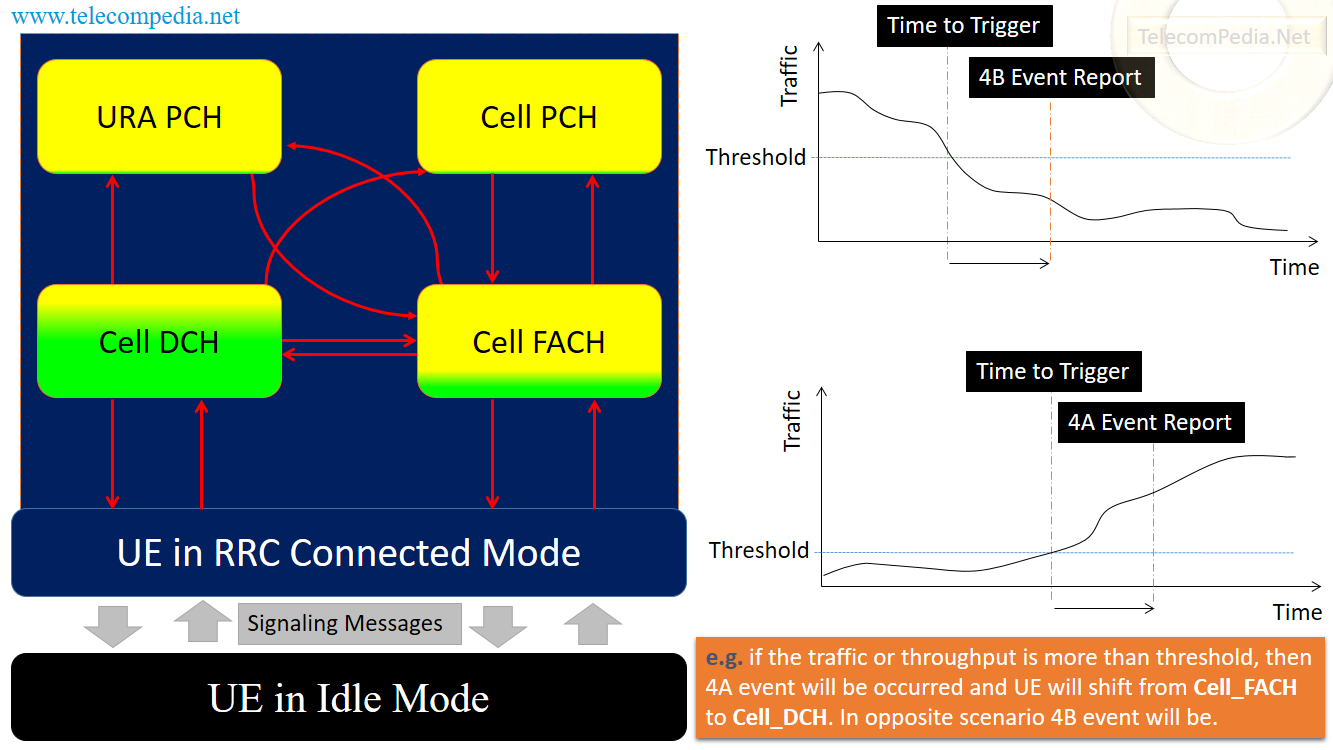Here we will imagine the UE only in 3G network.
When a 3G UE is powered on, firstly it starts to scan UMTS spectrum and tries to find strongest cell based on radio condition. This step is called as “cell selection”, and there are two kinds of selections which are:
– Initial cell selection: there is no prior frequency information at UE, and the UE needs to scan all UMTS frequency bands.
– Stored information cell selection: there is frequency and as well as cell information from the previously camped network. If the UE will not able to find the same frequency again from the stored information then it will use “Initial cell selection” scenario.
If the UE finished the cell selection procedure, then it stays in “idle mode” state. While idle mode condition, the UE will listen paging messages, system information messages, as well as cell re-selection (from serving cell to another cell) event can be happened during moving.
When the UE sets up an RRC Connection with UTRAN network due to some services, then the UE changes its condition from “Idle Mode” to “Connected Mode”. And this condition is known as RRC Connected State, there are four types of RRC Connected States and the UE might be switched between the states during connected mode because of its behavior (throughput value, traffic volume, reselection counts, cell update counts etc…):
• Cell_DCH State: The UE occupies dedicated channel and consumes a large amount of radio resources.
— Dedicated physical channel is allocated to the UE in uplink and downlink.
— The UE is known on cell level according to its current active set.
— Perform measurements and transmit measurement reports according to the measurement control information.
— State transition is not allowed if the UE has circuit switched service, the UE needs to stay in Cell_DCH state until the end of the service.
• Cell_FACH State: The UE uses the common channel to send or receive data, which occupies only a small amount of resources.
— No any dedicated channels are allocated for the UE in uplink and downlink.
— The UE continuously monitors a FACH in the downlink.
— The UE is known on cell level according to the cell where the UE made a cell update.
— Perform measurements and transmit measurement reports according to the measurement control information.
— During streaming services the UE can only be switched between Cell_DCH and Cell_FACH.
• Cell_PCH State: The UE can only receive messages from the UTRAN network, it cannot send any message to uplink direction. If the UE needs to transmit some data in uplink direction, then it needs to be transited to Cell_DCH or Cell_FACH states. This transition procedure is “Cell Update”. The UE position is known on cell level according to the cell where the UE made last cell update in CELL_FACH state.
— Neither an uplink nor a downlink dedicated physical channel is allocated to the UE.
— In the downlink direction, the UE uses DRX to monitor messages on the PCH. The purpose is to receive paging messages.
— Perform cell reselection and upon selecting a new UTRA cell, it enters to the CELL_FACH state and initiates a cell update procedure.
— Perform measurements according to the measurement control information
— When there is requirement to send data according to the measurement control information, the UE enters to the CELL_FACH state and transmits measurement reports.
• URA_PCH State: This state is a little bit different than Cell_PCH, so the UTRAN network can obtain UE location based on URA (UTRAN registration area) and can send paging messages to that area.
— Neither an uplink nor a downlink dedicated physical channel is allocated to the UE
— UE uses DRX to monitor messages on the PCH.
— Perform cell reselection and upon selecting a new UTRA cell that does not match the URA assigned to the UE, enter the CELL_FACH state and initiate a URA update procedure.
— Perform measurements according to the measurement control information.
— When there is requirement to send data according to the measurement control information, the UE enters to the CELL_FACH state and transmits measurement reports.
There is no restriction for switches between states if the UE has Interactive or Background services (web browsing, emailing, short message services etc…).
Purpose to use RRC Connected States:
✸ If there is data, then need to speed up services to be processed in time.
✸ If there is no data transmission requirement, network resources will be saved.
If the UE starts to set up RRC connection from Idle Mode (not from RRC Connection States), then it needs additional signaling messaging and it might cause resource consumption. That is the advantage of “RRC Connected States”.
